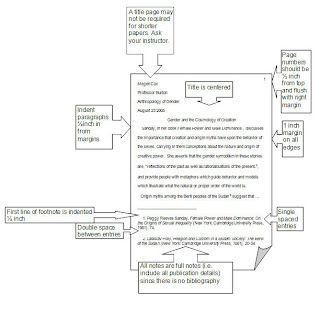Research Paper Format

Recommendations here are based on the MLA Handbook for Writers of Research Papers. It is important to note, however, that individual instructors and institutions or departments may vary from these recommendations somewhat and that it is always wise to consult with your instructor before formatting and submitting your work.
Paper:
Use white, twenty-pound, 81/2- by 11-inch paper. Erasable paper tends to smudge and should be avoided for a final draft. If you prefer to use erasable paper in the preparation of your paper, submit a good photocopy to your instructor.
Margins:
Except for page numbers (see below), leave one-inch margins all around the text of your paper -- left side, right side, and top and bottom. Paragraphs should be indented half an inch; set-off quotations should be indented an inch from the left margin (five spaces and ten spaces, respectively, on standard typewriters).
Spacing:
The MLA Guide says that "the research paper must be double-spaced," including quotations, notes, and the list of works cited.
Heading and Title:
Your research paper does not need a title page. At the top of the first page, at the left-hand margin, type your name, your instructor's name, the course name and number, and the date -- all on separate, double-spaced lines. Then double-space again and center the title above your text. (If your title requires more than one line, double-space between the lines.) Double-space again before beginning your text. The title should be neither underlined nor written in all capital letters. Capitalize only the first, last, and principal words of the title. Titles might end with a question mark or an exclamation mark if that is appropriate, but not in a period. Titles written in other languages are capitalized and punctuated according to different rules, and writers should consult the MLA Guide or their instructors.
Page Numbers:
Number your pages consecutively throughout the manuscript (including the first page) in the upper right-hand corner of each page, one-half inch from the top. Type your last name before the page number. Most word processing programs provide for a "running head," which you can set up as you create the format for the paper, at the same time you are establishing things like the one-inch margins and the double-spacing. This feature makes the appearance and consistency of the page numbering a great convenience. Make sure the page-number is always an inch from the right-hand edge of the paper (flush with the right-hand margin of your text) and that there is a double-space between the page number and the top line of text. Do not use the abbreviation p. or any other mark before the page number.

Tables and Figures:
Tables should be labeled "Table," given an arabic numeral, and captioned (with those words flush to the left-hand margin). Other material such as photographs, images, charts, and line-drawings should be labeled "Figure" and be properly numbered and captioned.
Binders:
Generally, the simpler the better. Why spend money on gimmicky, unwieldy, slippery binders, when instructors prefer nice, flat stacks of papers they can stuff into their briefcases and backpacks? A simple staple in the upper left-hand corner of your paper should suffice, although the MLA Guide suggests that a paper clip can be removed and this facilitates reading (which suggests to us that it's been a long time since the people at MLA have had to deal with stacks of student papers). Your instructors or their departments may have their own rules about binders, and you should consult with them about this matter.
Transport your vehicles visit this site: Auto shippers


I actually enjoyed reading through this posting.Many thanks.
ReplyDeleteThesis writing services
Heya¡my very first comment on your site. ,I have been reading your blog for a while and thought I would completely pop in and drop a friendly note. . It is great stuff indeed. I also wanted to ask..is there a way to subscribe to your site via email?
ReplyDeleteEssay Editing Service